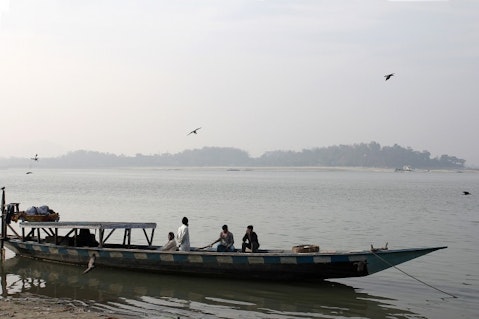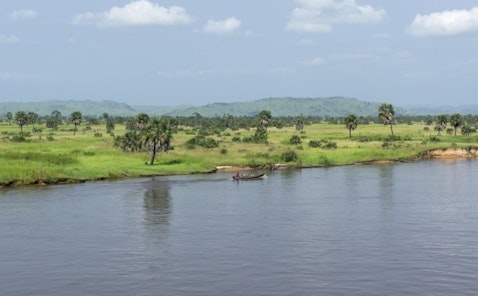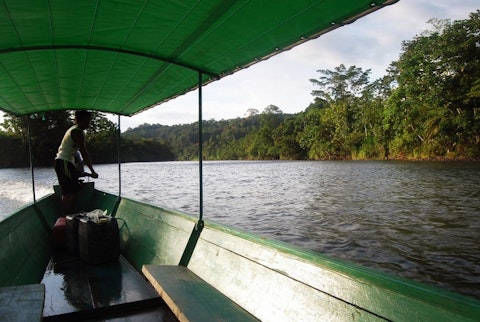These 10 largest rivers in the world by volume have been providing people living on their banks with food, water and means of transport for centuries. They are hailed as cradles of civilization, providing humanity with sustainable agriculture that gave rise to the first cities. It’s no wonder some of them are considered holy. The rivers have been instrumental in shaping our civilization since the dawn of the human kind, although some of them can be very dangerous (read more in our article on Most Dangerous Rivers in the World).

Alewtincka/Shutterstock.com
The river valleys often possess the most fertile land, a fact recognized by our ancestors. Once the first plants were domesticated and agriculture became a viable alternative food source, people started settling in towns along largest rivers in the world. The sheer volume of water these rivers had provided enough boost to the agriculture through irrigation of large areas that soon cities started developing. In Mesopotamia, this process started as early as 6,000 years ago, in 4th millennium BC.
Today, these largest rivers in the world haven’t lost its significance. Irrigation and transport in areas through which they flow are still very dependable on them. Most of them have been dammed, in order to harness their hydro potential and create electric power, further increasing their importance. Unfortunately, like with other natural resources, we have been rather careless with rivers. The levels of pollution are critical in several of the rivers on our list.
In order to create this list, we have excluded rivers that are tributaries of a larger river. This means cutting at least 3 Amazon tributaries (Madeira, Negro and Japura) as well as Parana, a tributary to Ro de la Plata. For the sake of clarity, we also excluded distributaries like Padma and Meghna, leaving the Brahmaputra as the sole representative of Ganges Delta on our list. Let’s see which other largest rivers in the world by volume are also on the list.
10.Mississippi
Volume: 16,792 m3/sec – 593,000 cu ft/s
Length:3,730 km /2,320 miles
Discharges to: the Gulf of Mexico
Mississippi features the largest drainage basin in North America, spreading from Canada to the Gulf of Mexico.

9.Saint Lawrence
Volume: 16,800 m3/sec – 590,000 cu ft/s
Length:3,058 km /1,900 miles
Discharges to: Gulf of Saint Lawrence
Number 10 on our list is Saint Lawrence River. It drains the Great Lakes Basin into the Atlantic Ocean. Its estuary at the Gulf of Saint Lawrence is one of the largest in the world.

Felix Lipov/Shutterstock.com
8.Lena
Volume: 16,871 m3/sec – 595,794 cu ft/s
Length:4,472 km /2,647 miles
Discharges to: Laptev Sea
Lena is the largest river whose entire watershed is completely inside Russia. Originating in Baikal Mountains, near the Mongolian border, Lena flows 2,647 miles north until it discharges into the Arctic Ocean.

7.Brahmaputra
Volume: 19,300 m3/sec – 681,600 cu ft/s
Length:2,840 km /1,765 miles
Discharges to: Padma River/Bay of Bengal
Due to high sediment load, Brahmaputra is classified as a braided river. A tidal bore, a phenomenon seen on only a few rivers, can be observed on the Brahmaputra.

6.Yenisei
Volume: 19,600 m3/sec – 692,167 cu ft/s
Length:5,550 km /3,449 miles
Discharges to: Kara Sea
Starting in Mongolia and cutting Russia in a south-north direction, Yenisei is the largest river that discharges into the Arctic Ocean.

5.Río de la Plata
Volume: 22,000 m3/sec – 777,000 cu ft/s
Length:3,998 km /2,484 miles
Discharges to: Atlantic Ocean
The first South American river and number 5 on our list of the largest rivers in the world by volume is Río de la Plata or Silver River. It is created by the confluence of Parana and Uruguay rivers.

4.Yangtze
Volume: 30,166 m3/sec – 1,065,302 cu ft/s
Length:6,418 km /3,988 miles
Discharges to: East China Sea
The Yangtze is the longest river in Asia. It has been crucial in Chinese history and today one-third of china’s population lives within Yangtze drainage basin, which constitutes one fifth of country’s territory.

3.Orinoco
Volume: 36,000 m3/sec – 1,165,384 cu ft/s
Length:2,140 km /1,330 miles
Discharges to: Atlantic Ocean
The Orinoco and its tributaries are the backbone of Venezuela’s and to lesser degree Columbia river transport system.

2.Congo
Volume: 41,200 m3/sec – 1,447,901 cu ft/s
Length:4,371 km /2,716 miles
Discharges to: Atlantic Ocean
The largest river in Africa by volume, Congo is also the deepest river in the world, with depths reaching more than 220 m (720 ft).

Skinstorm/Shutterstock.com
1.Amazon
Volume: 209,000 m3/sec – 7,381,000 cu ft/s
Length:6,453 km /4,010 miles
Discharges to: Atlantic Ocean
Amazon’s water volume is almost equal to the rest of the rivers on our list. That makes it the largest river in the world by volume by a huge margin.






